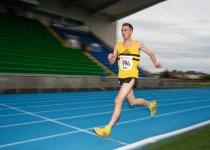- Messages
- 3,350
- Name
- Simon
- Edit My Images
- Yes
I've been hired to shoot an Athletics meeting tomorrow and the brief has just said be as creative as you like. I'll shoot all the standard shots but thought I would try some pans and drag the shutter. I had a practice tonight and got a couple I liked through trial and error. Has anyone got any tips for set up. I shot the images tonight with a AD300 off camera but that limits the area I can take the shot to in front of the flash. Perhaps a speedlight may be a better option and up the iso a wee bit. I'm looking to show a decent amount of blur so wanting something around 1/10th or a 1/20th shutter speed. All the races are 1500m minimum so the runner will be at a moderate pace.
Ideally what I would like is the chance to shoot two or three shots as the runners go by with runners frozen and background blurred through the pan. If the runners were a stop or so brighter than the background I think I would like that look too. So would the best bet be to get a shutter speed sorted first. Then a largish aperture like F4 and then get iso to the level needed to expose correctly. It is an evening meeting so shouldn't need ND filters. Next do I use TTL or manual flash. I guess I can shoot manual if panning side on as the distance won't change dramatically. If I am panning from around 45 degrees the distance will change so I dare say TTl will be needed.
Has anyone tried this before at Athletics or other outdoor sports. It could all be academic of course as I haven't had the use of flash approved yet
Ideally what I would like is the chance to shoot two or three shots as the runners go by with runners frozen and background blurred through the pan. If the runners were a stop or so brighter than the background I think I would like that look too. So would the best bet be to get a shutter speed sorted first. Then a largish aperture like F4 and then get iso to the level needed to expose correctly. It is an evening meeting so shouldn't need ND filters. Next do I use TTL or manual flash. I guess I can shoot manual if panning side on as the distance won't change dramatically. If I am panning from around 45 degrees the distance will change so I dare say TTl will be needed.
Has anyone tried this before at Athletics or other outdoor sports. It could all be academic of course as I haven't had the use of flash approved yet


